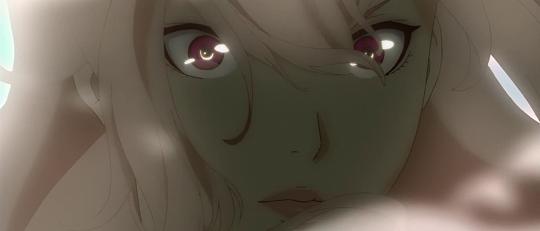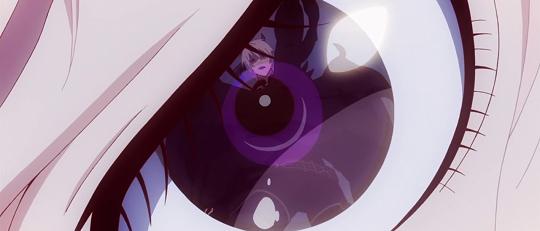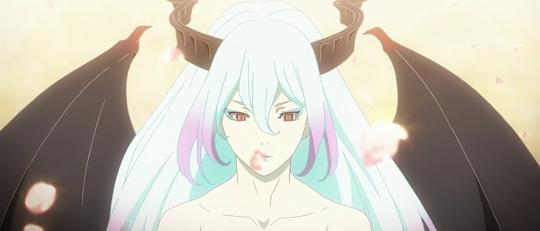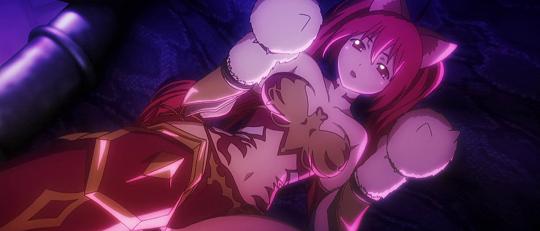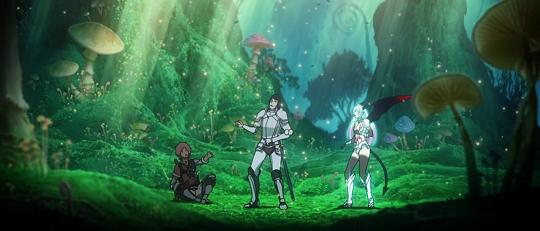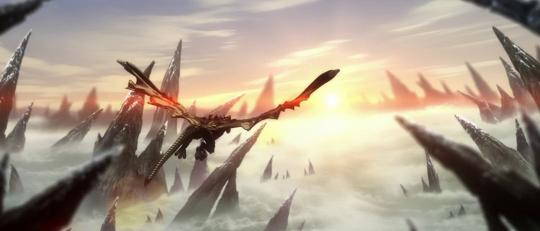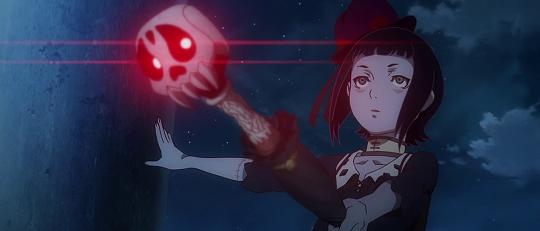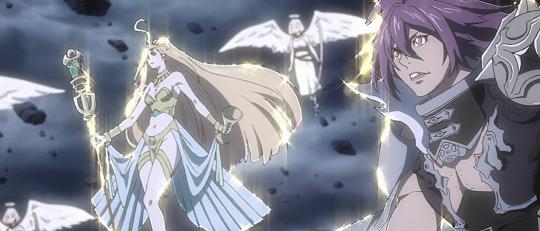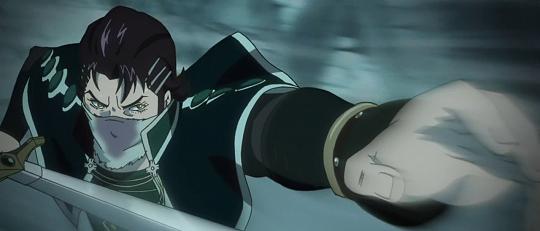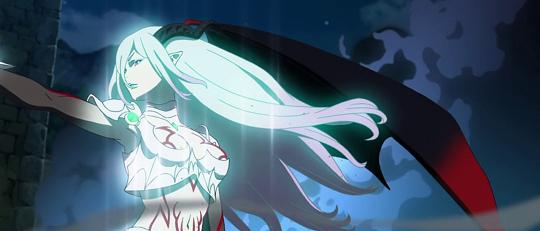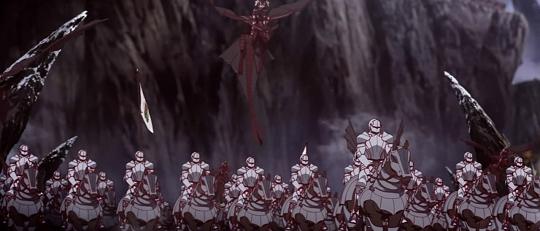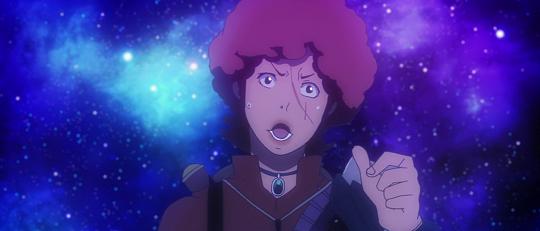After three episodes of Shingeki no Bahamut: Genesis (Rage of Bahamut: Genesis), I still wasn’t sure what I was watching. There’s nothing particularly abstract (yes Soultaker I’m talking about you) about the story of two feuding friends going on adventures with a girl from another world. Except, in the first few episodes there are so many different ways the series could have gone - monster of the week, Queen’s Blade journey into fan service, Escaflowne adventures in a fantasy world to name a few - but it seems bullheadedly determined not to go with any of them and instead play the whole series by ear.
Peculiarly, it works. And not just because it throws everything, kitchen sink and all, at you and to see what sticks. After all you have an Arabian deity (Bahamut) mixed in with Christian mythology (heaven, hell, angels and devils) with some added Norse flavouring (the heavenly god is in fact Zeus), some Pagan witchcraft and wizardry and some historical persons of note thrown in for good measure. Like the origin of the dragon personification of Bahamut then, Shingeki no Bahamut is a Dungeons and Dragons campaign in anime form. It has the overeager dungeon master cobbling together a piecemeal mythology with narrative abandon, the rollicking tales of a knight, a rogue and someone who wanted to play a female, and by the end of the campaign the adventurers are riding into battle on the back of a giant duck.
It’s ridiculous and perhaps not wholly knowingly so but ends up becoming the series’ mantra: fun and pragmatism trumps all. There’s no time for details or woolly naval gazing before it’s on to the next location from Bahamut’s travelogue of a world. Can we fit zombies in? Yeah why not. What about pirates? Only one way to find out! And the key reason this all works and doesn’t just degenerate into a haphazard mess can be laid at the feet of the cast.
Initially this is only a pair of bounty hunters consisting of the fallen knight Kaisar and impish rogue Favaro (sorry: Favaroooooooooo!) who kick the series off with a breakneck chase through a half Italian half generic-fantasy-world town, before meeting up with Amira. Pink-haired and demonstrably lethal, she gloms onto Favaro after he mentions he is travelling to the frozen wasteland Helheim. At this point it seems like the narrative will go the way of monster-of-the-week: new location, adventurers encounter evil, Amira destroys evil, tankards of mead all round. Except Kaisar is too busy trying to run Favaro through, while Favaro is too busy trying to get rid of Amira.
It’s this idiosyncratic setup that makes the core trio more interesting than just a myopically chivalrous do-gooder or serial rascal. Unfortunately Amira, despite being the poster child for the series, ends up with the most mercurial of personalities starting out with ice-queen aloofness before morphing into fresh-faced naivete that, as a girl alien to these lands, seems understandable yet both personas are sheepishly lampshaded as the series closes out. You’ve barely time to notice that though because it’s not long before a cynical zombie necromancer (with a jaunty little hat) joins up, Jeanne d’Arc makes an appearance as does Lucifer, Beelzebub and Satan. As three separate entities ranging from sparkly to sinister.
There’s an awful lot going on despite the overriding story being fairly straightforward, but having an anime series with multiple large scale battles replete with knights, wizards, wyverns and all manner of other beasties is an absolute delight to see. For the most part it also maintains a credible level of visual fidelity, keeping Amira and co. lusciously detailed while piling on the effects. Twenty story high golems clobber enemies with Jeanne d’Arc leaping into battle wielding an oversized spear, fireballs raining around her. It’s a aesthetic riot and handled supremely well by post-Madhouse studio MAPPA with extensive use of CG that oscillates from “pretty good for anime” through to “our rendering farm melted so here’s something we cobbled together”.
It is surprising to see such lush visuals given that the series has no light novel or manga source and thus, no existing barometer for fan interest. What’s even more surprising is that it eschews standard anime practice by not merchandising itself into oblivion: no opening or ending singles and the home video release touts a very generous three episodes per instalment. The only conclusion then is the Rage of Bahamut mobile card collecting game (CCG) source must be doing very well for itself to fund this kind of lavish outlay.
With most anime relying on hyper-intensive marketing just to break even, it’s heartening to see such an entertaining series birthed from a different revenue source, especially so because freemium mobile games are renowned for being little more than cynical cash grabs. It’s a situation that shouldn’t have worked, but did. Just like the series opening that I initially scoffed at, resigning it to the same thrash metal bin of Maximum the Hormone’s Death Note offerings, yet found myself listening to it on repeat not two weeks later. Just like Favaro and Kaisar’s relationship that should be grating but ends up being touching without the spectre of brotastic fist bumps.
Not everything is roses though. The world the characters inhabit may be varied and interesting with great plains of floating mountains or dark forests wreathed in mist but it lacks integrity; we are told that Favaro and Amira are heading towards Helheim but with no clue as to whether it is a physical place or squirreled away amongst the heaven/hell/extradimensional hokum that the series dabbles in. And there’s not enough Jeanne d’Arc. Although there could arguably never be enough of her leading noble armies against betentacled demon hordes...
Regardless, Shingeki no Bahamut: Genesis remains a silly but enjoyable series. A lot of that is probably down to Tiger and Bunny director Keiichi Satou corralling so many disparate ideas into a coherent, if not totally cohesive whole. Yes it sometimes cleaves a little close to the mediocre Karas for which he previously served as director, but by and large joy rather than po-faced seriousness wins out. Given the subtitle “Genesis” and the end title card’s “I’ll be back!”, there is obviously the desire to continue this franchise; as it stands though the series ended exactly where it needed without belabouring the idea of a pissed-off dragon indiscriminately destroying everything. Like a typical D&D campaign then, the series muddled through accruing a handful of hilarious, stand-out moments as well as some shaky missteps along the way.
